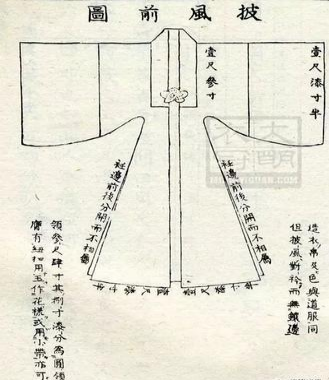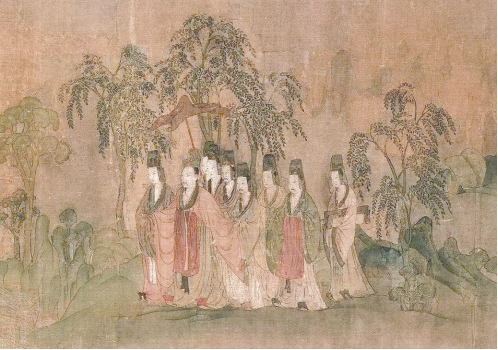The patterns for Hanfu originated in the Pre-Qin period. According to 《Li Ji · Shen Yi》,it was documented that plane pattern making and “cross-shaped” pattern making were used at the time, with “making twelve pieces to correspond to the twelve months” reflecting the application of pattern-making techniques in Hanfu. By the Han Dynasty, the technology had matured, as evidenced by the silk robes unearthed from the Mawangdui Han Tomb, which showed the pattern-making styles of curved and straight hems, indicating that the preliminary designs for pattern-making charts had taken shape. Since the fabric width of the Han Dynasty was about 50 cm, the pieces needed to be distributed according to the width of the fabric, marking the initial design of “divided-width pattern-making.”

The Development Process of Hanfu Pattern-Making
From the Wei and Jin Dynasties to the Song Dynasty,This period marked the development of Hanfu pattern-making, characterized by diversity. Styles such as “Yoke-front Long-sleeved Jackets” and sleeveless short garments emerged, with the latter primarily worn by nomadic ethnic groups of the time; women’s skirts featured a style called “Broken Skirts” that employed multiple trapezoidal pieces for patchwork. During this era, the design on front-opening jackets showed left-right symmetry, demonstrating more standardized and refined pattern-making, and an increase in the number of skirt pieces.
During the Qing Dynasty: Due to the promotion of Manchu clothing, Hanfu became marginalized, with pattern-making only being secretly preserved in individual areas of folk culture.

Modern Hanfu Pattern-Making
Modern Hanfu pattern-making builds on the foundations of multi-piece patchwork like Ming Dynasty pleated skirts and Tang Dynasty Broken Skirts, adhering to the principle of “no darts, flat pattern-making” while preserving traditional elements such as pleats, yoke, or center-front openings. It also incorporates modern fashion design concepts and Western waist-cinching tailoring. Based on contemporary wear needs, some typical pattern-making charts have been developed, such as the structure of Hanfu lolita skirts and standing collar center-front opening armored suits.
Comparison of Ancient and Modern Style Designs
| Dimension | Ancient Hanfu (Before the Qing Dynasty) | Modern and Contemporary Hanfu |
| Style | The styles were relatively fixed, mainly including shenyi (deep robe), quju, zhiju, ruqun, yuanlingpao (round-collar robe), etc. | On the basis of retaining traditional elements, many improved styles have appeared, such as dresses, Hanfu coats, etc., to adapt to the needs of modern life. |
| Material | Natural fabrics such as silk, cotton, and linen were mostly used. | In addition to traditional natural fabrics, modern fabrics such as chemical fiber and blended fabrics are also used. |
| Craftsman ship | Handicraft techniques such as embroidery, brocade, and kesi were adopted, and plant or mineral dyes were mainly used for dyeing. | While retaining some traditional handicraft techniques, modern machine embroidery and chemical dyeing are combined. |
| Wearing Occasions | It was worn in daily life, and must be worn in sacrifices, rituals, and festivals. | It is mainly used in cultural activities, traditional festivals, weddings, photography, and other occasions. |
| Common Accessories | It was often matched with coronets, belts, jade pendants, etc. | It can be freely matched with modern clothes. |
With technological advancements, Hanfu will incorporate more technological elements. Some yet-to-be discovered or nearly lost pattern-making techniques will be further enhanced and inherited. Digital and intelligent technologies will be applied in Hanfu production, such as 3D printing technology to automatically generate personalized pattern-making charts, and AR/VR technology to simulate the wearing effects of different Hanfu styles.







